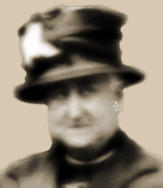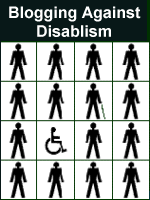BADD has rather sneaked up on me this year. This may be on account of BADD 2008 having only taken place a couple of weeks ago. (If that doesn't make any sense to you, just wait until you're middle-aged.)
I had been intending to be the sort of sensible person who drafted her BADD entry last weekend. But it was sunny and there were flowers to photograph. Well, that and I couldn't think of anything to write about. Which is not to say that there aren't all manner of things which I
could write about, you understand.
I
could tell you about the poor man who phoned me in tears one morning last week because his managers don't seem to be able to grasp that they have an obligation to make what is actually a very straightforward reasonable adjustment and because his colleagues are making fun of him because he's different.
I
could tell you about a diversity awards ceremony I recently attended at which some bumptious idiot introduced his own self-important slot in the proceedings with the words, "Right! I want everyone in the room to stand up!"
I
could tell you about the "revised" national parking policy which actively discriminates against a high proportion of an organisation's disabled staff.
But I don't want to tell you about any of those things. Partly because it would be tricky to do so in detail without identifying the victim/culprit/organisation/myself, and partly because, in all honesty, I'm fed up to the back teeth with those particular issues.
How kind, then, of one of the people who works in (or, at least, is paid for attending) my building to have made the effort of dropping ideal BADD-fodder into my lap this week. You're going to
love this...
But first, some background:-
I have worked on the fourth floor of a four-floor office building for about ten years. For even longer than that (see how I assume only
young people read blogs?), the building's "fire lifts" have been used to evacuate those disabled people whose impairments prevent them from hurtling down the stairs with their non-disabled colleagues during fire drills and genuine emergencies.
But not any more.
The landlords, in their infinite wisdom, have decreed that the "fire lifts" don't meet the necessary specs to be used for this purpose. And, in fact, they never
did. So, to spare you the long, tedious rounds of negotiation and counter-argument, let's cut straight to the result: no more being evacuated in the lift.
A colleague and I
can make it down all the stairs we need to get down in order to get out of the building
if we really have to. But we would both have to go straight home thereafter, and it would take us both a day or two to recuperate. So our Personal Evacuation Plans (PEPs) stipulate that we will
only attempt that descent in a genuine emergency.
(I'm relieved to report that there hasn't been one of those since the lift-use was barred: I'm hoping there
won't be until after my team has moved down to the first floor. But back to the main story.)
There was a fire drill a few weeks ago. My colleague and I had been informed of the drill in advance, and had confirmed that we wouldn't be taking part, thank you. As had quite a few other slowly crips in various corners of the building.
(And, if you think not going out during a fire drill is a soft option, then you've never sat through nine minutes of deafening, head-exploding, all-encompassing fire alarm.)
A report on how the fire drill went was circulated last week, and made it as far as yrs truly by last Friday. One read of the offending object was sufficient to raise my blood pressure to dangerous levels. I shut the email down carefully until such time as I might have calmed down enough to put together a coherent response.
Wherein did it offend me? Right at the very end. After all the observations about the number of people who were spotted going back to their desks for their coats/handbags/cups of coffee, and those who were discovered, on re-entry, not to have had their building passes with them that day, was this little gem:-
"As the drill did not test the evacuation of people with serious mobility problems, a concern was raised that had these people been included, the evacuation time would have been much longer." Well, that's
me told, then, isn't it? Somebody is labouring under the common delusion that there's a time limit on evacuating the building completely, and what am
I doing? Interfering with some jobsworth's ambition to meet this mythical deadline, apparently.
Blimey. How selfish am
I?
As punishment for this insupportable determination to scupper the best laid plans of mice and men, I should clearly, at this point, volunteer to stay in the building and burn to death. It would be the least I could do, after causing "a concern". That or get myself all better - because my impairments are probably all in the mind anyway - so that I can scamper downstairs efficiently and help this numpty win his building-emptying Guinness World Record bid.
Seriously, though, in what bizarre, alternate universe is the fact that the safe evacuation of disabled people is going to increase the overall length of time it take to fully evacuate a particular office building something to be concerned about? By whose scheme of logic is this a problem? Who can't sleep at night for worrying that, although there are plans to get "these people" out safely, "these people" still can't move as quickly as "normal people"? Who - and let's stop messing around, here - hasn't actually understood what his employer's H&S responsibilities are as regards emergency evacuations?
I was lucky enough to have a good teacher about this subject way back when I first needed a PEP. He has long since retired, naturally, so can't be wheeled in to beat some sense into The Man With A Concern. But here is what I learned.
The purpose of an emergency evacuation is to get everybody away from danger as quickly as possible. You expedite this by getting everybody who can get out quickly under their own steam out
first. In the meantime, those who
can't move as quickly are making their way, with their "buddies", towards fire refuges. Fire refuges have a considerably greater level of fire resistance than the more open plan areas of the building.
Each of the slowly crips has a carefully-agreed, detailed plan of where and when they will go next, and under what specific circumstances. That plan incorporates the way in which their status will be communicated to the Incident Control Officer (ICO). My own plan isn't nearly as complicated as some. It doesn't involve teams of Evac Chair handlers, or me moving through various compartments of the building as successive refuges start to become unsafe. It involves me setting off down the (fire-protected) stairs once it's safe for me to do so, and making my way down them at a speed which is manageable for me. Various members of my team are responsible either for staying with me to make sure nothing unforeseen happens, or letting the ICO know I've begun my descent.
This means that, when the first fire engine arrives, and the senior fire officer asks the ICO whether everyone is safe, the ICO can honestly reply that all those who don't need a PEP are already out, and that the location and progress of all the slowly crips is known,
and that none of them is in danger. At which point, said senior fire officer will direct his staff to saving
the building.
If, on the other hand, the first fire engine arrives, the senior officer asks the ICO whether everyone is safe, and the ICO replies that
most people are, but he or she has a vague suspicion that about a dozen slowly crips probably couldn't keep up with the mandatory deadline for getting out, so no-one knows where they are, the fire officer will direct his staff to put on breathing apparatus and sweep the building in search of
the people. And, if that means the building burns to the ground, then so be it. Because the Fire Service - unlike, apparently, at least
one of my colleagues - values human life more highly than inanimate buildings. Yes, even the life of someone, like me, who can't walk very quickly.
The Enraged Editor
Labels: BADD













